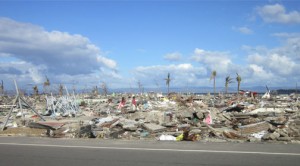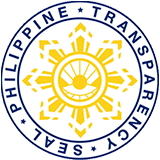
Three days after the onslaught of Super Typhoon “Yolanda” in the Visayas Region, nine employees from the Department of Social Welfare and Development – Cordillera Administrative Region (DSWD-CAR) were the first to sign-up to provide augmentation in Leyte.
Eight days they stayed in Tacloban City to provide help and support to the victims of typhoon, and came back with a lifetime of experience and lessons to share.
People behind the operation
Edmundo Panganiban, 59, was the first one to sign up for the relief augmentation.
“Bago pa lang sila magtawag ng mga gustong mag-volunteer, nagpasabi na ako na gusto kung magpunta sa Tacloban para sa relief operation. Noong ibinabalita palang sa TV, lalo na yung nakita kong eksena kung saan yung tatay buhat-buhat nya yung namatay nyang anak, sabi ko sa sarili ko pupunta ako doon para makatulong kahit paano. Ang sa akin, hindi man ako social worker, naniniwala akong may maitutulong rin ako sa kanila,” Edmundo said.
His tools and skills in carpentry provided big help in setting up the partially ruined warehouse that a businessman had turned over to the DSWD to use as repacking station.
“Halos kami pa lang ang unang pumunta doon kaya kami nag-ayos ng mga bodegang ginamit. Sa pag-aayos ng mga kableng nasira at bubong, nagamit ko pagiging karpentero ko at gamit ko na sadya kong dinala doon,” Edmundo relived ardently.
Up in the air inside the Osprey aircraft, Edmundo described the devastated town like a place attacked with atomic bomb.
“Sira lahat. Hindi mo akalain na ganon ang epekto ng bagyo. Mas malakas pa sa tsunami ang tumama sa kanila,” Edmundo added
This immense type of relief operation was the third time for Edmundo to partake including the operations in 1990 earthquake here in Baguio City and 1991 Mt. Pinatubo eruption. On the other hand, Joel Lamsis shared that this was his first time to participate in this kind of activity.
“Hindi ko akalain na ganon ka-grabe yung pinsala. Kailangan ng mga tao ng pagkain kaya unang inasikaso namin ay yung pagsasaayos ng relief lalo na ang repacking,” Joel said. “Sa sobrang dami ng tao na nangangailangan ng relief goods, naisip ko na parang di kakayanin ng supply kung di maayos pagbibigay ng goods.”, he added.
People were rushing to the station to get food packs and the crowd clearly outnumbered the team. More than a couple of times did the team called for order among the crowd to have a systematic distribution of goods.
“We are on a crisis level. If we let things get off hand especially in releasing relief goods to people, sino lang makakakuha? Halimbawa yung sinasabi nila na pag-air drop ng mga pagkain, yung mga malalakas lang makakakuha. Kawawa ang mga sugatan at mga matatanda. Survival of the fittest ito,” Joselito Cabuñag, another volunteer from the Department, said.
The volunteers were divided into two: those who manage the supply and those who manage the campsite.
Marcia Espinueva, Supplementary Feeding Program Focal Person of the DSWD-CAR, was one of those stationed in managing the campsite. They were tasked on coming up with the master list of all casualties in the twelve barangays in Tacloban and managing food-for-work scheme in the campsite.
“Para maayos at malinis yung Tacloban Astrodome na nagsilbing evacuation center, nagsagawa na kami ng food-for-work para sa mga nasalanta ng bagyo. Isang bagay ito para maayos din ang pagbibigay ng relief goods sa mga evacuees,” Marcia said.
Marcia admitted that she was hurt with the news that the agency especially the relief team was monopolizing the relief goods.
“Gusto ko ipaalam na kami sa relief team ay ginagawa lahat ng makakaya namin lalo na sa pagsasaayos ng pamumudmod ng relief goods. Kung alam lang nila na ang sitwasyon dun ay nasa survival level na, madalas ay nagkakagulo na ang mga tao sa pagkuha ng relief. Ang sa‘min, may interview sa mga nasalanta para malaman namin kung ano ang kailangan nila at kung ano na ang naibigay sa kanila,” Marcia said.
Failure of words
They admitted that during their augmentation in Tacloban, they were moved and, beyond doubt, this experience had changed their perspective in life.
“It was a very humbling experience. It made me appreciate small things in life,” Joselito said. “No one can prepare you for that. Kahit gaano pa ang gawin mong pagpaplano, kung darating sa ‘yo ang ganoong trahedya, pwedeng mawala sa ‘yo lahat. Makikita mong karamihan sa kanila, nawalan na ng pag-asa.”
“Mahirap i-describe, mahirap i-equate sa salita. Kahit sina Webster at Merriam, mapapahiya dahil di nila madedefine yung nangyari doon, yung naramdaman ng mga tao doon,” Joselito shared.
“Words were not enough and the actual happening there could not be quantified. Maliit palang yung nagawa namin doon for me to feel that we made an impact. To sum it up, marami pang kailangang gawin at marami pa tayong maitutulong,” Joselito added.
The second batch of the relief team is now stationed at the DSWD- National Resource Operations Center (NROC). They would also stay there for eight days. As for the first batch, they were willing to provide augmentation again.
The strongest typhoon that struck Visayas this year almost sapped out the life of the communities. Many people were killed. Many are still missing. Sturdy trees were uprooted. Infrastructures were wreaked. And yet, this calamity pushed people to take action and to hope and live again. # DSWD-CAR, SOCIAL MARKETING UNIT, KAYE ANN O. MAPALO




